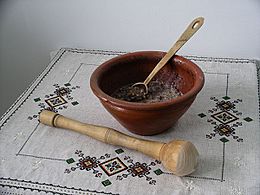Kutia facts for kids
 |
|
| Main ingredients | Wheatberries, poppy seeds, honey or sugar, various nuts and sometimes raisins |
|---|---|
Kutia (say: koo-TYAH) is a special grain dish. It has a sweet sauce and is often served during holidays. People in countries like Ukraine, Belarus, and Russia traditionally eat it.
Kutia is important for Eastern Orthodox Christians and Byzantine Catholic Christians. They usually eat it during the Christmas and Feast of Jordan holidays. It can also be part of a meal after a funeral. Sometimes, the word "kutia" also describes the evenings before these holidays.
Contents
What's in a Name?
The word kutia comes from the ancient Greek language. It means "bean" or "grain." This makes sense, as grains are the main part of this dish!
Kutia in Ukraine
In Ukraine, kutia is one of the two most important dishes for the Ukrainian Christmas Eve Supper. This special meal is also called Svyata vecherya. Kutia and another dish called uzvar have been important for a very long time. Some experts think they have been around since the Stone Age!
Christmas Eve Traditions
Before dinner, the kutia is placed in a special spot. This is usually in the corner of the house, under the icons. This corner is seen as the most honored place. The pot of kutia stays there from Christmas until the Old New Year (January 14).
There is also a fun tradition where children take kutia to their relatives. They often visit grandparents and godparents. After dinner, the kutia is left on the table all night. Spoons are left with it for family members who have passed away. This is so they can "have dinner and not be angry with us."
Inviting the Frost
An old custom shows how important kutia is. The head of the family takes a spoonful of kutia. They go to the window or outside and call out to the frost three times. They invite the frost to join the family for dinner. If the frost does not come, they ask it not to harm the crops. They might say, "Frost, frost, come eat kutia with us. If you don't come, don't harm our rye, wheat, and other crops."
First Bite of Kutia
Kutia is the very first of the twelve dishes eaten at the Svyata vecherya meal. The head of the family takes the first spoon. They hold it up and invite the spirits of family members who have passed away to join them. Then, they taste the kutia. They might even throw some of the spoonful up to the ceiling!
People believe that the number of grains sticking to the ceiling means good things. It can show how many bees will swarm or how many new cattle will be born. The number of poppy seeds on the ceiling might show how many eggs hens will lay. After this, everyone present eats a spoonful of kutia. Then, the other dishes are brought out and enjoyed.
What Kutia is Made Of
Traditional kutia is made with wheatberries, poppy seeds, and honey. Sometimes, people add walnuts, dried fruit, and raisins. Kutia is a Lenten dish. This means it does not use milk or egg products. Some recipes use pearl barley or millet instead of wheatberries.
There is a similar Ukrainian dish called Kolyvo. It is like kutia but does not have poppy seeds. Kolyvo is usually served at remembrance services.
Kutia Around the World
Many other countries have similar dishes. These dishes are made with boiled grains, honey, nuts, and spices. Here are some examples:
- Bulgaria – kolivo
- Greece – koliva
- Lebanon, Palestine and Jordan – ameh masslouk or snuniye
- Romania – colivă
- Russia – (also) sochivo
- Serbia – koljivo (meaning: sacrifice), or simply: žito (meaning: wheat)
- Sicily – cuccìa
- Syria – sliha or burbara (for Eid il-Bur-bara, St. Barbara's Feast throughout the Middle East)
There is also an Islamic sweet dish called Ashure. It is somewhat similar but has different origins and ingredients.
See also
 In Spanish: Kutia para niños
In Spanish: Kutia para niños

